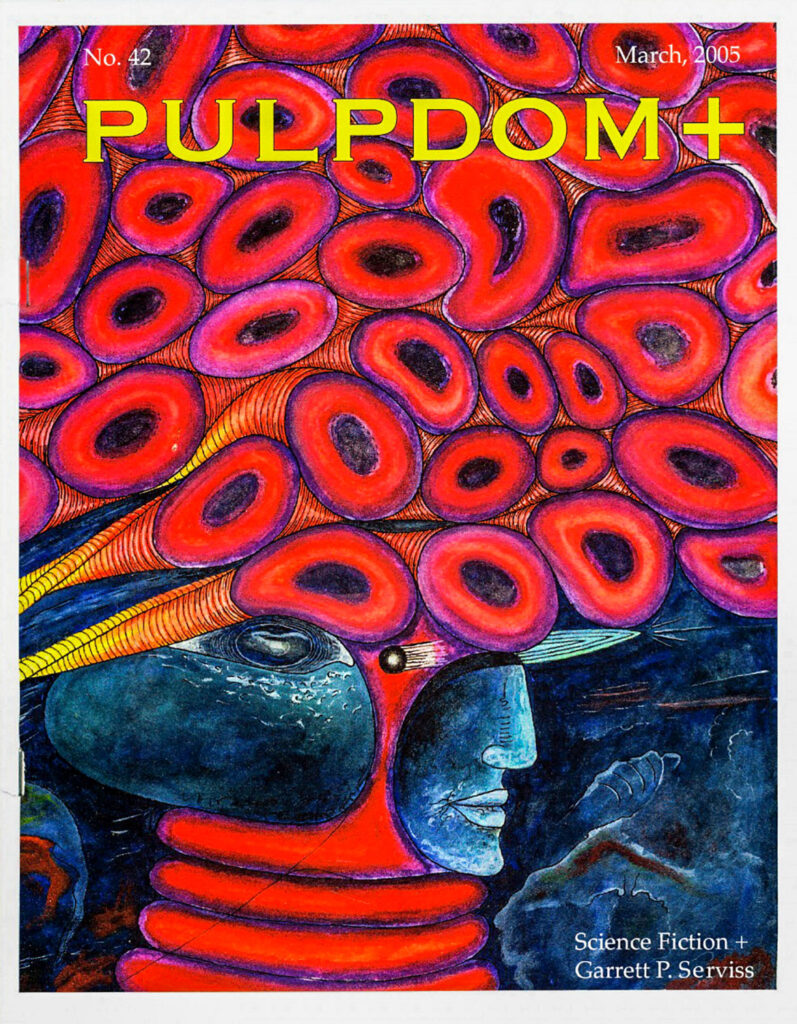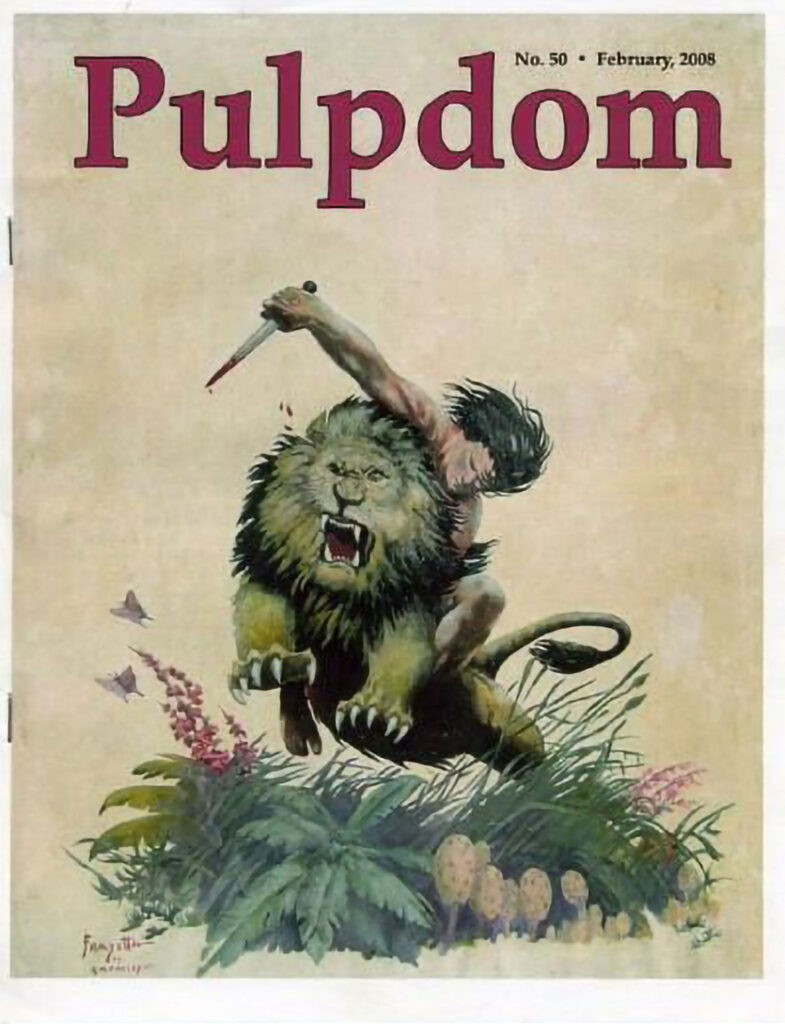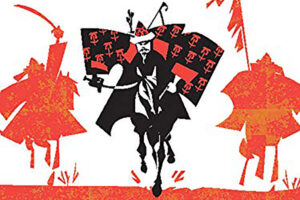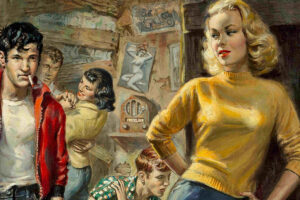As with other issues, these are all 28 to 32 pages, side-stapled, reprinting early pulp fiction with various non-fiction articles and artwork, both new and old,focusing on the early pulps. In some issues, the non-fiction works are more prominent, in some cases pushing out any fiction reprints, and, for me, these are almost more interesting. All have cover colors, with some interior color.
Again, with this fanzine, you also need to pay attention to letters, editorials, and the like, as there is useful and interesting information there as well as in the more formal articles. Often these are follow up and additions to articles and items from prior issues.
 #41 (January 2005): Under a nice G.M. Farley cover, we have a mixture of fiction and articles. First up is an article from Caz on Street & Smith’s The New Magazine (October 1910-July 1911), which became New Story Magazine (August 1911-November 1915), then All Around Magazine (December 1915-March 1917). It was originally Gunter’s Magazine (1905-10). We get a listing of selected authors who appeared in it, like H. Rider Haggard, Edgar Rice Burroughs, J. Allan Dunn, and H. Bedford-Jones. We also get three pages, in color, of covers. R.A. Bennett‘s “The Bowl of Baal” and Bedford-Jones’ “>The Buddha’s Elephant,” both of which I’ve reviewed, appeared in these magazines. We also get “Bru the Bird Woman” by J. Allan Dunn from All Around Magazine (January 1917).
#41 (January 2005): Under a nice G.M. Farley cover, we have a mixture of fiction and articles. First up is an article from Caz on Street & Smith’s The New Magazine (October 1910-July 1911), which became New Story Magazine (August 1911-November 1915), then All Around Magazine (December 1915-March 1917). It was originally Gunter’s Magazine (1905-10). We get a listing of selected authors who appeared in it, like H. Rider Haggard, Edgar Rice Burroughs, J. Allan Dunn, and H. Bedford-Jones. We also get three pages, in color, of covers. R.A. Bennett‘s “The Bowl of Baal” and Bedford-Jones’ “>The Buddha’s Elephant,” both of which I’ve reviewed, appeared in these magazines. We also get “Bru the Bird Woman” by J. Allan Dunn from All Around Magazine (January 1917).
From Mike Taylor is a review of Notes on Australian Science Fiction. Caz provides an brief article plus the start of a bibliography of James Francis Dwyer (1874-1952), who wrote for the pulps and had several books, many reprints of his pulp works. Sadly, no one has made an effort to reprint him since, and he is apparently the first Australian to become a millionaire as an author. I would be interested in his lost-world work, “The City of the Unseen” from Argosy, whose cover we see on the back of the zine.
We also get a trio of reviews of some of Dwyer’s pulp novels that were reprinted in books at the time. First is his first novel, The White Waterfall, from 1912. It’s a South Seas adventure with elements of lost worlds; then another adventure tale, The Green Half-Moon, in 1915; and then Breath of the Jungle, which is actually a collection of a dozen stories, from 1915. We then get a one page reprint from his autobiography, Leg-Irons on Wings (1949), where he speaks of getting into the pulps. I think he would be a good candidate for Steeger Books to reprint.
#42 (March 2005): This issue has a very strange science-fiction-y cover by Jacques Wyrs, which is appropriate as the focus is on science fiction and Garrett P. Serviss. First up is a detailed look by Vince Nowell Sr. at Hugo Gernsback‘s final attempt at a science-fiction magazine: Science Fiction Plus. It ran eight issues in 1952-53, and even had Sam Moskowitz on board as managing editor. Next from Joseph Wrzos is an article on early sf author Garrett P. Serviss (1851-1929), with a focus on his most well-known work, The Second Deluge. Armchair Fiction has reprinted that in a deluxe illustrated edition, and Steeger Books is doing a two-volume(?) omnibus reprinting of his works, but only the first volume is out. Serviss was an astronomer and science populizer. He wrote an unauthorized sequel to H.G. Well‘s The War of the Worlds, and would write a half-dozen science-fiction works in total. Finally, we get an article on Fritz Leiber Jr. (1910-92) who wrote the Fafhrd and the Gray Mouser series of stories, and one authorized Tarzan novel, Tarzan and the Valley of Gold, a movie novelization, which has recently been reprinted.
#43 (July 2005): This time the focus is on Talbot Mundy, starting with a cover from Adventure in 1929 that highlights one of his works. We get a long biography of Mundy (1879-1940) by Bill Garwood. Mundy had a very interesting life, which gave him the background for his writings, and this includes his involvement with certain religious groups like Theosophy. This is a good bio with lots of cover and interior artwork. Mike Taylor provides an overview of Street & Smith’s Complete Stories which ran from 1924-37, with several color covers.
#44 (October 2005): This issue starts off with an original cover by Doug Beekman. The bulk of this issue is an article by Mike Taylor on Top-Notch, a general-interest pulp from 1910-37. This is a revision/expansion of his article from issue #13. Published by Street & Smith, Top-Notch was originally a boy’s magazine/dime novel before becoming a pulp focused on sports and ship stories before switching to adventure in the 1930s. Some works include the Speed Dash series by Erle Stanley Gardner in the late ’20s, and Lester Dent‘s first published work, “Pirates of the Cay” in 1929. We also get several covers, and we see they went with an interesting styling in 1930 and ’31 to stand out on the newsstands.
In 1930, we get a series starring Kroom, Son the Sea, a Tarzan-like character who was shipwrecked as a baby in the South Pacific and raised by a race of semi-aquatic people who live within an extinct volcano. The series ran almost 20 stories by Valentine Wood, a house name, over the next two years. The house name was also used for the later Ozar the Aztec series that ran for six stories in 1933. He was another Tarzan-like character. Ozar’s parents were sacrificed by a lost band of Aztecs, but their infant was spared due to a prophecy, and became Ozar. So these are two early pulp heroes I’ve never heard of. Neither have been reprinted, and they are probably still owned by Conde Nast. Several authors wrote for Top-Notch, including Bedford-Jones, Anthony M. Rud and J. Allan Dunn.
Mike Taylor then gives us a sidebar article on J.H. Rosny, a pair of French writers and brothers. One goes by the name “J.H. Rosny the Elder,” and the other “J.H. Rosny, Junior.” The elder brother is better known as the “Edgar Rice Burroughs of France,” whose best-known work is Quest for Fire (1911), which was made into a movie in 1981, and Hareton Ironcastle, translated and embellished by Philip José Farmer. Black Coat Press has put out seven volumes of his works.
From Al Lybeck is a review of a couple of obscure novels by an obscure author, W. Adolphe Roberts: The Haunting Hand (1926) and The Mind Reader (1929). However, I found that his autobiography was recently published by a university!
From Caz is a brief article on western pulps before 1930, and another looking at early western pulp cover art. We get about three pages of covers.
#45 (Feb 2006): This one has a Tarzan cover, which is appropriate as the issue is devoted to a single article by Mike Taylor on “The Legacy of The Ape Man” and covers nearly 30 pulp, comicbook, and fiction characters who were inspired by Tarzan. Some were somewhat copies of Tarzan, like Ki-Gor, others were more inspired by him, but set in different parts of the world, raised by other species, etc. Some I have heard of, but several I hadn’t. These include: Polaris of the Snows, Bomba the Jungle Boy, Kroom, Jan of the Jungle, Sangroo the Sun God, Kaspa the Lion Man, Kwa of the Jungle, Ozar the Aztec, Kioga of the Wilderness, Ka-Zar, Mataala, Jongar of Lost Land, Sojarr of Titan, Tharn, Toka, Sheena Queen of the Jungle, Lord Tyger, and Bunduki. Many are available via reprints.
#46 (June 2006): This issue kicks off with Foreign Legion cover by Walter Baumhofer from Adventure. It’s appropriate as a big chunk of this issue is devoted to “The Foreign Legion in Pulps,” first with an article by Al Lybeck. It kicks off with an except from the beginning of H. Bedford-Jones 17-part series on the Foreign Legion,”Warriors in Exhile,” that ran in Blue Book and was reprinted by Steeger Books. We then get a series of reviews of other authors of Foreign Legion pulp stories, sometimes with their entry from the series of articles called “The Men Who Made the Argosy.” The first is on J.D. Newsom (1893-1954), who wrote Legionnaire stories. High Adventure #175 reprints several of his Legionnaire stories.
Next are two reviews of novels by George Surdez (1900-49), the first reprinted in book form: “Swords of the Soudan” (Argosy 1923) and “Sons of the Sword” (Adventure 1928). We also get his article in “The Men Who Made the Argosy.” Then there’s a review of Theodore Roscoe‘s “The Heads of Sergeant Baptiste” (Argosy 1938). This is one of his Thibaut Corday stories, all of which have been reprinted in four volumes by Steeger Books. This one is the title story of Vol. 4. Steeger has other volumes of Roscoe’s works, as does Bold Venture Press who published his biography. We also get his article from “The Men Who Made the Argosy.”
Finally, we have a review of Frederick C. Painton‘s (1896-1945) “The Road to Damascus” (Argosy 1938), and a review of “Sahara Squadron” (Adventure 1951) by Robert Carse (1902-1978). “Sahara” was published when the magazine was but a ghost of its heydays. We also get his article from “The Men Who Made the Argosy.”
From Mike Taylor is an article on a short-lived Clayton pulp: Soldiers of Fortune that ran for four issues in 1931. Adventure House does have a facsimile of the first issue. Monte Herridge covers the Det. X. Crook series that ran for some 50 stories in Flynn’s/Detective Fiction Weekly in 1925-29 by British detective novelist J. Jefferson Farjeon. Many of his British publications have been reprinted of late, but no idea if this series has been.
Finally, we get some Tarzan-related pieces. One is an outline for an essay by Douglas Candland, edited by Georges Dodds, titled “The Incunabular Ape-Man Writings,” which is include if it will be published. And we get a translation of a French pulp work, “The Missing Link: A Mysterious Encounter on the Island of Borne” by Marcel Roland, from a 1914 magazine. I do see that Dodd edited a collection of early ape-man stories that included “The Missing Link” called The Missing Link and Other Tales of Ape-Men from Black Coat Press in 2010.
#47 (December 2006): With another G.M. Farley cover, we have several works. Georges Dodds follows up previous issues with an article on early French novels on sf and the Foreign Legion, examining a trio of works by Capitaine Danrit (1855-1916). Then we get a reprint of an article by Vanity Fair from 1933 looking at pulp magazines. Mike Taylor gives what would have been his response to it. Joseph T. Shaw, the well-known editor of Black Mask, actually wrote a rebuttal to this that was recently reprinted in Windy City Pulp Stories #20.
Continuing from earlier issues (#24 and 39), we get a look at the short novels and serials in The Argosy for 1912 through 1916, with several covers. And we get a reprint of an H. Bedford-Jones’ Foreign Legion short story from The Argosy in 1914 under his Allen Hawkwood alias: “A Point of Honor.” Mike Taylor has a more detailed article on The Argosy in 1917.
#48 (March 2007): This one has a nice J. Allen St. John cover. This issue continues with showcasing works of pre-Tarzan stories and characters, especially from the research of Georges Dodd. But first we get a look by Mike Taylor at The Blue Book from 1905-20. As I’ve posted on, The Blue Book was one of the “Big Four” of the pulps. This is supposed to be the first of a series of works on this pulp, and should be read along with Mike Ashley‘s work that I noted in my post. Monte Herridge looks at Flynn’s/Detective Fiction Weekly, which ran from 1924-42. A lot of good series ran here, including the Park Avenue Hunt Club and Satan Hall, along with Johnston McCulley‘s Thubway Tham. I might have to post on just this pulp magazine.
 We get a reprint of another pre-Tarzan work: “The Little Boy and the Elephant” by Gustavus Frankenstein (??) from St. Nicholas Magazine in 1900. Yes, that is his name. And there’s a review of H. Rider Haggard’s The Ivory Child (1916). Which first appeared in the U.S. as a serial in The Blue Book.
We get a reprint of another pre-Tarzan work: “The Little Boy and the Elephant” by Gustavus Frankenstein (??) from St. Nicholas Magazine in 1900. Yes, that is his name. And there’s a review of H. Rider Haggard’s The Ivory Child (1916). Which first appeared in the U.S. as a serial in The Blue Book.
#49 (November 2007): This issue is focused on Ganpat and Frank Aubrey (aka Francis Henry Atkins, Fenton Ash), etc, who has been covered before in Pulpdom. Richard Dalby provides a look at “Ganpat,” a British author of lost-world fantasies. Ganpat was really Martin Louis Alan Gompertz (1886-1951). He wrote some 20 or so novels in the 1920s, set in the Himalayas, an area he was aware of as an Anglo-Indian officer. But it doesn’t look like anything has been reprinted.
From Caz and K. Emmet is a look at U.K. author Frank Aubrey, who was really Francis Henry Atkins (1840-1927), also known as Fenton Ash and Frank Ashley. He’s probably best known for the trilogy of The Devil Tree of El Dorado, Queen of Atlantis, and King of the Dead that Armchair Theater has reprinted. Included is a bibliography of all is works under his various names. We get a reprint of his “A Newfoundland Terror” (1896).
We get several reviews. First is one of Lee Server‘s Encyclopedia of Pulp Fiction Writers (2002). I wondered if this work was worth getting. Next is the reprint of Harold Hersey‘s The New Pulpwood Editor from Adventure House in 2002, which I’ve reviewed here. The Adventure House Guide to Pulps (2000) that I also reviewed. And the first edition of Bookery Fantasy’s Ultimate Guide to Pulps (2001), which I don’t have. I’ve reviewed the most recent one. Finally, reviews of a pair of reprints by Black Dog Books: Harold Lamb‘s The Skull of Shirzad Mir and George Allan England‘s The Empire of the Air.
#50 (February 2008): The zine starts with a Tarzan cover by G.M. Farley inspired by Frank Frazetta, and the theme is “Lions and Jungles” with some pre-Tarzan stories of “boys in the jungle” and a couple of reviews. The two stories are “Bobbili” by William Murray Graydon taken from his Jungles and Traitors (1902) set in India about a “panther boy,” and “Joe the Jungle Boy: Being the Adventures of a Boy Who Was Carried Off by Gorillas” from The Washington Post (1903). Yes, newspapers did run fiction for decades.
The reviews are The Lion City of Africa (1890) by Willis Boyd Allen and Jungle-Born (1924) by John Eyton.
As always, it’s a very eclectic run of issues. These may be obtained in PDF form from the publisher for $50 for all 101 issues. Finding original hardcopies may be difficult, as some want to jack up the price. And you run the risk, as I’ve found, that some may have printed out the PDF and slap a high price on them. So, watch out.
Going through these issues I noted several authors who are being reprinted now, but also several that haven’t been but may deserve to be. Hopefully this will inspire their rediscovery. I’m not sure when my posting on the next set of issues will appear, but keep an eye out for it.




Thank you Mr. Brown, i’d forgotten some of those articles myself. Pulpdom had only about a hundred subscribers back in those days (15 years ago), i could never get the support of the “big pulpers” back then, they carefully ignored what we were doing, never wrote any reviews, and generally pretended we didn’t exist. Confirmed by Matt M. who said he never heard of it. —> You are the only person who has reviewed all that work.